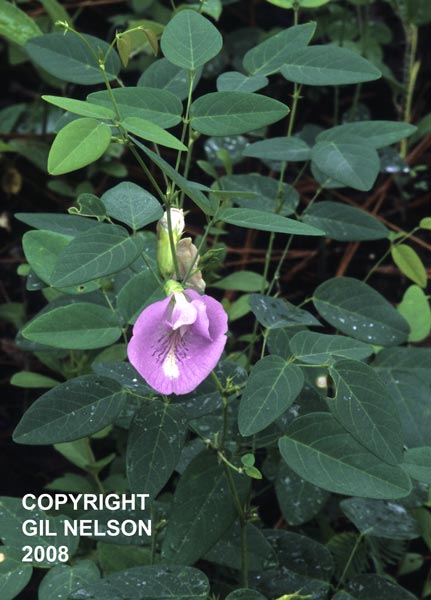Clitoria mariana
| Clitoria mariana | |
|---|---|

| |
| photo by Gil Nelson | |
| Scientific classification | |
| Kingdom: | Plantae |
| Division: | Magnoliophyta - Flowering plants |
| Class: | Magnoliopsida – Dicotyledons |
| Order: | Fabales |
| Family: | Fabaceae ⁄ Leguminosae |
| Genus: | Clitoria |
| Species: | C. mariana |
| Binomial name | |
| Clitoria mariana L. | |

| |
| Natural range of Clitoria mariana from USDA NRCS Plants Database. | |
Contents
Description
Common Name: Atlantic pigeonwings
Distribution
Ecology
Habitat
It occurs in frequently burned longleaf pine-turkey oak sandhills (FSU Herbarium), sand pine scrub (Greenberg 2003) (Entisols), flatwoods (Spodosols) (Brewer and Cralle 2003) and and upland longleaf pine-wiregrass communities (Ultisols), as well as the margins of mixed hardwood communities (FSU Herbarium) and loblolly pine plantations (Cushwa 1966). It ranges from dry (Walker and Peet 1983) to moist sandy areas (FSU Herbarium). It can live in partially shaded areas (54% ambient light conditions) (Cathey et al 2010). It can be found in longleaf pine flatwoods communities (Brewer and Cralle 2003). It is also found in loblolly pine communities (Cushwa 1966). It can also be found in sand pine scrub (Greenberg 2003). It thrives in frequently burned areas, and typically occurs in high light environments, but also tolerates partial shade (FSU Herbarium). Although it occassionally occurs in frequently burned old-field communities, it is more typical of native pine communities which have minimal soil disturance.
Phenology
It flowers May-August and fruits September-October.
Seed dispersal
Seed bank and germination
Fire ecology
Because it was found in Henley Park plots which were burned every one to two years in the winter, it is fire-tolerant (Brewer and Cralle 2003). It resprouts quickly after fire, which can be supported by the fact that it resprouted within a month after fire in Pavon's study (Pavon 1995). It attained its peak in two-year rough plots at Henley Park, plots that had undergone two growing seasons since the last burn (Brewer and Cralle 2003). This is supported by Greenberg's study, which shows the peak percent cover to be 16 months after fire around 80% (Greenberg 2003).
Pollination
Use by animals
It is a game-food plant (Cushwa 1966), so it is probably consumed by Gopherus polyphemus, white-tailed deer, and bobwhite quail (Hainds et al 1999).
Diseases and parasites
Conservation and Management
Cultivation and restoration
Photo Gallery
References and notes
FSU herbarium herbarium.bio.fsu.edu
Greenberg, C. H. (2003). "Vegetation recovery and stand structure following a prescribed stand-replacement burn in sand pine scrub." Natural Areas Journal 23: 141-151.
Brewer, J. S. and S. P. Cralle (2003). "Phosphorus addition reduces invasion of a longleaf pine savanna (southeastern USA) by a non-indigenous grass (Imperata cylindrica)." Plant Ecology 167: 237-245.
Cushwa, C. T. (1966). The response of herbaceous vegetation to prescribed burning. Asheville, USDA Forest Service.
Walker, J. and R. K. Peet (1983). "Composition and species diversity of pine-wiregrass savannas of the Green Swamp, North Carolina." Vegetatio 55: 163-179.
Cathey, S. E., L. R. Boring, et al. (2010). "Assessment of N2 fixation capability of native legumes from the longleaf pine-wiregrass ecosystem." Environmental and Experimental Botany 67: 444-450.
Hainds, M. J., R. J. Mitchell, et al. (1999). "Distribution of native legumes (Leguminoseae) in frequently burned longleaf pine (Pinaceae)-wiregrass (Poaceae) ecosystems." American Journal of Botany 86: 1606-1614.
Pavon, M. L. (1995). Diversity and response of ground cover arthropod communities to different seasonal burns in longleaf pine forests. Tallahassee, Florida A&M University.